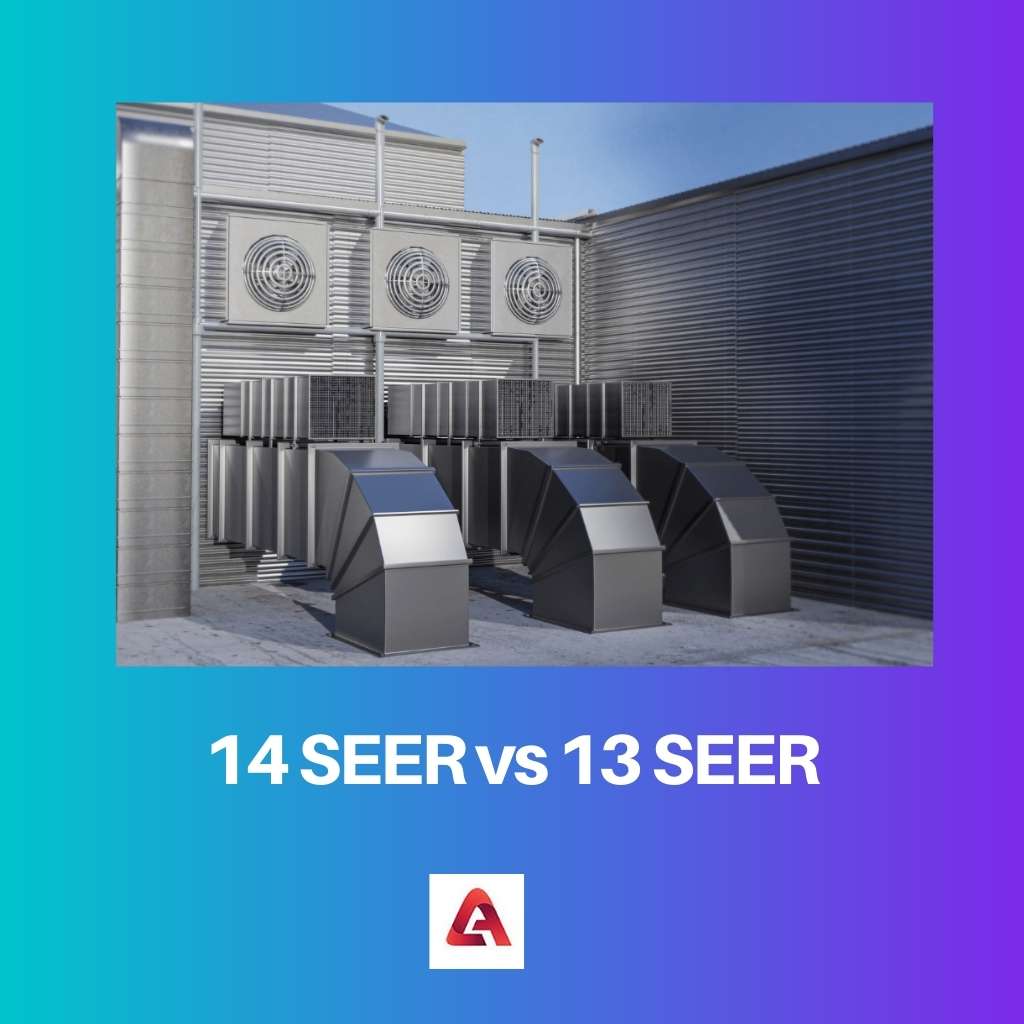SEER stands for Seasonal Energy Efficiency Ratio. It is a system of rating that permits a person to rapidly determine the energy efficiency of an air conditioner.
In general, the higher the SEER, the less electricity an air conditioner would need to run and the more energy efficient it would be, which becomes more feasible for people. This ratio is calculated by cooling output during summer divided by energy used during summer.
Key Takeaways
- SEER (Seasonal Energy Efficiency Ratio) measures the efficiency of air conditioning systems.
- A 14 SEER air conditioning system is more energy efficient than a 13 SEER system, which uses less energy to cool the same space.
- A higher SEER rating means a higher upfront cost for the system but lower long-term operating costs.
14 SEER vs 13 SEER
The difference between 14 SEER and 13 SEER is that the air conditioning systems with 13 SEER are less energy efficient than the systems with 14 SEER. As the air conditioning models with 14 SEER provide higher efficiency thus they are in higher demand than 13 SEER air conditioning models.

The air conditioning models with 14 SEER provide better energy efficiency than the AC models with SEER 13, 8, or 9. The 14 SEER AC models are single-stage compressors.
Many countries have mandated it to install air conditioning models with 14 SEER to maintain greater energy efficiency and protect the environment.
13 SEER is the minimum standard SEER for air conditioning models. According to the Environmental Protection Agency (EPA), a 30 percent increase in minimum energy efficiency requirements for air conditioning models is represented by 13 SEER.
Comparison Table
| Parameters of Comparison | 14 SEER | 13 SEER |
|---|---|---|
| Efficiency | 14 SEER is more efficient than 13 SEER and other previous SEERs. | 13 SEER is 28-30 percent more efficient than the previous SEERs but less efficient than SEER 14. |
| Size | 14 SEER is about 10 to 25 percent larger and heavier in size. | 13 SEER is lighter and smaller in weight as compared to 14 SEER. |
| Electricity Usage | 14 SEER requires less energy to run than 13 SEER. | 13 SEER requires less electricity. |
| Power Usage | 14 SEER uses 7.2 percent less power to run. | 13 SEER requires more power to run as compared to 14 SEER yet not as efficient as 14 SEER. |
| Running Time | 14 SEER AC models runs for about 10-15 years. | 13 SEER AC models run for about 7-8 years. |
What is 14 SEER?
The 14 SEER is a rating by which the energy efficiency of the air conditioning models is determined or measured. The higher the rating, the greater energy efficient your air conditioning model is.
The 14 SEER is the most common type of air conditioning model system. The outer unit of the system includes the condenser coil and compressor, whereas the inner unit of the system includes a fan and evaporating coils.
The coils used in the system have different appearances and measurements.
Air conditioning models with 14 SEER are mainly installed in business offices and houses. Today 14 SEER units are about 15-30 percent more energy efficient than average HVAC units used about 10-15 years ago.
Installation practices and tools required for installation 14 SEER are the same as the tools and practices required in 13 SEER. 14 SEER AC models are standard energy efficient. Installation of 14 SEER models might get a bit more complex than the installation of 13 SEER models.
In many countries, it is mandatory that all new air conditioning models must have at least a 14 SEER, which will make the present baseline for greater energy efficiency. The mandatory move from 13 SEER to 14 SEER will prove to be great and convenient for our environment.
What is 13 SEER?
13 SEER gives an improvement of about 28-30 percent in the energy efficiency of the models as compared to previous SEER air conditioning models. 13 SEER units gained much in minimizing fossil fuel consumption and restricting air pollution.
13 SEER air conditioning models are standard energy efficient. Air conditioning models with 13 SEER are mainly used in houses and business offices.
The maximum standard SEER for air conditioning models is 21 and it goes down to 13 SEER air conditioning models. The installation processes and tools required are less complex as compared to that of SEER 14 models.
13 SEER air conditioning models have a single-stage compressor, which will provide only one speed as the compressor runs at one fixed speed.
A standard 13 SEER air conditioning model would offer a diminished indoor comfort compared to any SEER models which are greater than 13 SEER. A change from 13 SEER air conditioning models to 14 SEER air conditioning models will use about 7.2 percent less power and energy to run.
Main Differences Between 14 SEER and 13 SEER
- Air conditioning models with 14 SEER runs at more BTUs than air conditioning models with 13 SEER.
- Air conditioning models with 14 SEER are 7 percent more efficient than the air conditioning models with 13 SEER.
- The average lifespan of a 14 SEER air conditioning models is longer than that of 13 SEER air conditioning models.
- Both the SEER, SEER 14, and SEER 13 are capable of providing cooling to you but SEER 13 AC models might find it difficult to work on hot humid days.
- 14 SEER air conditioning models uses less energy and power yet provides greater efficiency and cooling than that of 13 SEER.
- https://link.springer.com/article/10.1245/s10434-007-9566-6
- https://acsjournals.onlinelibrary.wiley.com/doi/abs/10.1002/cncr.29334
